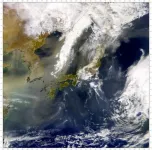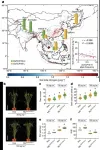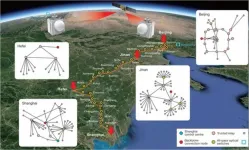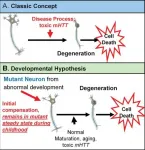Will global warming bring a change in the winds? Dust from the deep sea provides a clue
Westerlies moved poleward in the past, as they are doing now
2021-01-06
(Press-News.org) The westerlies--or westerly winds--play an important role in weather and climate both locally and on a global scale, by influencing precipitation patterns, impacting ocean circulation and steering tropical cyclones. So, finding a way to assess how they will change as the climate warms is crucial.
Typically, the westerlies blow from west to east across the planet's middle latitudes. But scientists have noticed that over the last several decades, these winds are changing, migrating poleward. Research suggests this is because of climate change. But, scientists have been debating whether the poleward movement of the westerlies will continue as temperatures and atmospheric carbon dioxide (CO2) increase further under future warming scenarios. It's been difficult to resolve this scientific question because our knowledge of the westerlies in past warm climates has until now been limited.
In a paper published January 6 in Nature, climate researchers from Columbia University's Lamont-Doherty Earth Observatory describe a new method of tracking the ancient history of the westerly winds--a proxy for what we may experience in a future warming world. The lead author, Lamont graduate student Jordan Abell and his advisor, Gisela Winckler, developed a way to apply paleoclimatology--the study of past climate--to the question of the behavior of the westerly winds, and found evidence suggesting that atmospheric circulation patterns will change with climate warming.
The finding represents a breakthrough in our understanding of how the winds changed in the past, and how they may continue to change in the future.
By using dust in ancient, deep sea sediments as an indirect tracer of wind, the researchers were able to reconstruct wind patterns that occurred three to five million years ago. Knowing that winds--in this case the westerlies--transport dust from desert regions to faraway locations, the authors examined cores from the North Pacific Ocean. This area is downwind from Eastern Asia, one of the largest dust sources today and a known dust-generating region for the past several million years. By measuring the dust in cores from two different sites thousands of kilometers apart, the researchers were able to map changes in dust, and in turn the westerly winds.
"We could immediately see the patterns. The data are so clear. Our work is consistent with modern observations, and suggests that wind patterns will change with climate warming," said Abell.
They found that during the warm parts of the Pliocene (a period three to five million years ago, when the Earth was about two to four degrees Celsius warmer than today but had approximately the same concentration of CO2 in the air as we do now), the westerlies, globally, were located closer towards the poles than during the colder intervals afterwards.
"By using the Pliocene as an analogue for modern global warming, it seems likely that the movement of the westerlies towards the poles observed in the modern era will continue with further human-induced warming," explained Winckler.
The movement of these winds have huge implications for storm systems and precipitation patterns. And while this research does not indicate exactly where it will rain more or less, it confirms that the wind and precipitation patterns will change with climate warming.
"In the Earth history record, tracking down movements of wind and how they've changed, that's been elusive because we didn't have a tracer for it," said Winckler. "Now we do."
INFORMATION:
Robert Anderson from Columbia University's Lamont-Doherty Earth Observatory and Brown University's Timothy Herbert were co-authors on this study.
Scientist contacts:
Jordan Abell
jabell@ldeo.columbia.edu
Gisela Winckler
winckler@ldeo.columbia.edu
More information:
Senior science editor Kevin Krajick
kkrajick@ei.columbia.edu | 917-361-7766
[Attachments] See images for this press release:

ELSE PRESS RELEASES FROM THIS DATE:
2021-01-06
What The Study Did: The findings of this survey study suggest that simply providing maps with COVID-19 case information wasn't necessarily associated with improved public knowledge, risk perception or reported intent to adhere to health guidelines.
Authors: Angela Fagerlin, Ph.D., of the University of Utah in Salt Lake City, is the corresponding author.
To access the embargoed study: Visit our For The Media website at this link https://media.jamanetwork.com/
(doi:10.1001/jamanetworkopen.2020.33538)
Editor's Note: The article includes conflict of interest disclosures. Please see the article for additional ...
2021-01-06
What The Study Did: Changes in out-of-hospital cardiac arrests and fatalities in the Detroit area during the COVID-19 pandemic are compared with year-earlier events for the same period in this observational study.
Authors: Adrienne V. Nickles, M.P.H., of the Michigan Department of Health and Human Services in Lansing, is the corresponding author.
To access the embargoed study: Visit our For The Media website at this link https://media.jamanetwork.com/
(doi:10.1001/jamanetworkopen.2020.32331)
Editor's Note: The article includes conflict of interest disclosures. Please see the article for additional information, including other authors, author contributions and affiliations, conflict of interest and financial disclosures, and funding and support.
INFORMATION:
Media ...
2021-01-06
Writing, driving a screw or throwing darts are only some of the activities that demand a high level of skill. How the brain masters such exquisite movements has now been described in the journal "Nature" by a team of researchers at the University of Basel and the Friedrich Miescher Institute for Biomedical Research. A map of brainstem circuits reveals which neurons control the fine motor skills of the arm and hand.
Picking up a pen and writing our name or reaching for a fork to eat spaghetti with tomato sauce are things we take for granted. However, holding a pen properly or bringing spaghetti to the mouth without making a mess requires precise ...
2021-01-06
Chinese scientists from the Institute of Genetics and Developmental Biology of the Chinese Academy of Sciences (CAS) have found a gene that plays an important role in helping rice adapt to low soil nitrogen.
Nitrogen fertilizer application is a strategic challenge for sustainable agriculture: On the one hand, it plays an indispensable role in increasing crop yields, thus ensuring global food security. On the other hand, it creates a severe threat to ecosystems. For this reason, breeding new crop varieties with high nitrogen use efficiency (NUE) is a high priority for both agricultural production and environmental protection.
Using a diversified rice population derived from different ecogeographical regions, the scientists carefully evaluated how various agronomic traits responded to ...
2021-01-06
Chinese scientists have established the world's first integrated quantum communication network, combining over 700 optical fibers on the ground with two ground-to-satellite links to achieve quantum key distribution over a total distance of 4,600 kilometers for users across the country. The team, led by Jianwei Pan, Yuao Chen, Chengzhi Peng from the University of Science and Technology of China in Hefei, reported in Nature their latest advances towards the global, practical application of such a network for future communications.
Unlike conventional encryption, quantum communication is considered ...
2021-01-06
SYRACUSE, N.Y. - There's no doubt the Earth's temperatures are going up. According to a December report by the World Meteorological Organization, 2020 is on track to be one of the three hottest years on record, already within the warmest decade to date. During the year's hottest months, many people rely on electricity-generated cooling systems to remain comfortable. But the power plants that keep air conditioners pushing out cold air could soon be in a vicious cycle in a warming world-not able to keep up with growing demands on hotter days and driving up greenhouse gas emissions ...
2021-01-06
Amsterdam, NL, January 6, 2021 - There is growing evidence to support the hypothesis that there is a neurodevelopmental component to the late-onset neurodegeneration occurring in the brain of huntingtin gene (HTT gene) mutation carriers, and that this increased susceptibility to brain cell death begins during childhood. Experts discuss the evidence that the HTT gene mutation affects brain and body growth based on a unique study of children at risk for HD, the Kids-HD study, in a review paper and accompanying research article published in the Journal of Huntington's Disease.
The classic concept is that Huntington's disease is caused by toxic mutant huntingtin (mHTT) acting over time on mature brain cells. However, there is growing evidence for an alternative ...
2021-01-06
Engineers at the University of Maryland (UMD) have created a new shape-changing or "morphing" 3D printing nozzle that was featured as a Frontispiece in the January 5th issue of the journal Advanced Materials Technologies.
The team's morphing nozzle offers researchers new means for 3D printing "fiber-filled composites" - materials made up of short fibers that boost special properties over traditional 3D-printed parts, such as enhancing part strength or electrical conductivity. The challenge is that these properties are based on the directions or "orientations" of the short fibers, which has been difficult to control during the 3D printing process, until now.
"When 3D printing with the morphing nozzle, the power lies on ...
2021-01-06
A survey of approximately 5,000 Americans suggests that 31.1 percent of the U.S. public does not intend to get the COVID-19 vaccine once it becomes available to them - and the likelihood of vaccine refusal is highest among Black Americans, women and conservatives.
Timothy Callaghan, assistant professor at the Texas A&M University School of Public Health, led the study with the aim of better understanding the intentions of the American public regarding vaccines. The results were recently published in Social Science and Medicine.
According to the study, survey respondents answered a series of questions about their behaviors and attitudes about COVID-19, including why or why not they intend to pursue vaccination. Women are 71 percent ...
2021-01-06
In a paper published by the journal Matter, engineers from the University of Surrey together with partners from Harvard University, University of Science and Technology of China, UK National Physical Laboratory, George Washington University and Zhejiang University Ningbo Research Institute report on how they have developed a breakthrough sensor system and manufacturing process.
The global team of engineers reveal that the new contact lens sensor system contains a photodetector for receiving optical information, a temperature sensor for diagnosing potential corneal disease and a glucose sensor ...
LAST 30 PRESS RELEASES:
[Press-News.org] Will global warming bring a change in the winds? Dust from the deep sea provides a clue
Westerlies moved poleward in the past, as they are doing now






